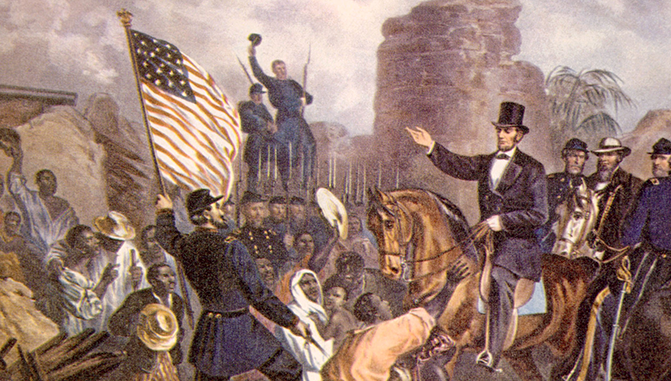Course Feature: HIS 101: United States History 1

HIS 101: United States History is an introductory course on the early history of the United States, from pre-European contact Native American societies to the end of the Reconstruction era after the Civil War. This course introduces the major political, social, and economic trends in the American colonies and new nation from the 15th through the mid-19th centuries. The course also focuses specifically on diversity and the cross-cultural encounters that contributed to the creation of the United States. HIS 101 is also the first half of a two-course sequence; HIS 102: United States History II continues the story from Reconstruction through the recent past.
Through unique and inventive written assignments, students gain a first-hand understanding of the topics covered by stepping into the mindset of the past. Faculty program director Mary Berkery explains, “In one assignment, for example, students write a newspaper editorial in support of one candidate in the crucial turning-point election of 1800. HIS 101 uses open educational resources (freely accessible, openly licensed text, media, and other digital assets), including an innovative textbook called “The American Yawp,” written collaboratively by hundreds of historians.
The book works on any device, including tablets and mobile phones, and comprises 30 chapters divided into two volumes, split chronologically in 1877. Berkery notes students also go beyond the textbook to examine primary sources like letters, political cartoons, and speeches to understand American history from the perspective of those who lived it.
“This course focuses on the untold histories of marginalized groups in our founding and early republic,” says Berkery. HIS 101 considers early American history from the perspective of Native Americans, slaves, religious and ethnic minority groups, and women. This course also teaches crucial skills that will help students in future coursework and in a wide variety of careers, including primary source analysis, historical research and writing, and critical thinking, adds Berkery.
Berkery indicates that the students who would be most interested in HIS 101: United States History would be those interested in America’s origins, including America’s colonization, interaction between European, African, and Native American cultures, the Revolution, the development of an infant republic, westward migration, and the causes and consequences of the Civil War; students who would like to do upper-level course work in U.S. history, as this course provides a solid foundation in historical research, writing, and critical thinking skills; and students who are interested in courses without textbook costs.
Students have had praise for the class, saying, “If you are interested in the history of the United States and what really led up to the Civil War then this is the course to take,” and “…knowledge is power, and knowing what happened in our nation’s history is very crucial and an important piece of knowledge. You can understand the origin of things and why things are the way they are now.” They have also enjoyed the open online resources: “I really enjoyed the online textbook. ‘The American Yawp’ was interesting reading. Since it is online, I was able to read it across multiple devices.”
Course instructors have also noted how enjoyable HIS 101 is to teach, saying, “I think it is really a well-designed class. The discipline of history is well-represented with using the primary and secondary resources and an emphasis on integrating them to create responses and assignments,” and “I really like the assignments that asked students to think about what they learned and present the information in a creative way such as the assignment to write an editorial.”
If you would like to learn more about our nation’s history, consider signing up for HIS 101: United States History for next semester.


